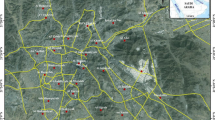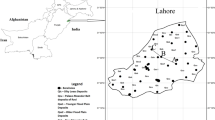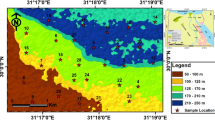Abstract
Preparing maps for geotechnical characterization in earthquake-prone areas is significantly important for decision-makers and local-planners in order to reduce loss of lives. This study presents a series of maps for Erzincan city, which is mostly located in a deep alluvial basin in nearby area of North Anatolian Fault Zone (NAFZ). The maps for addressing certain physical properties of soils Atterberg’s limits, classification, standard penetration test (SPT), shear wave velocity (Vs), and primary wave velocity (Vp) findings in the region have been prepared using field-based methods and geotechnical data of 92 available boreholes in Erzincan. The geological units underlying the city is consisted of various amounts of silt, clay, gravel, and sand, while it is predominantly classified as either low plastic clay (CL) or medium plastic silt (SM). Liquid limit (LL) and plastic limit (PL) values varied between 28–45% and 5–24%, respectively. The lowest SPT blow counts were found to be in southern part of the Erzincan city. The northern parts with the highest Vs values (higher than 1000 m/s) have been determined as very dense cohesionless soils. Furthermore, a correlation performed via NN between the unconfined compression testing results and dynamic elastic modulus from field studies yielded a very high correlation coefficient (R2=0.97). Evidently, the GIS maps produced by inverse distance weighting (IDW) method could be efficiently used by engineers as well as researchers for the purpose of land-use planning and urban development in earthquake-prone regions.













Similar content being viewed by others
References
Akyildirim A (1993) In terms of engineering geology survey of Erzincan location area in accordance with settlement. Istanbul Technical University, Graduate School of Natural and Applied Sciences, M.Sc. Thesis, 248
Alemdag S, Gurocak Z, Cevik A, Cabalar AF, Gokceoglu C (2016) Modeling deformation modulus of a stratified sedimentary rock mass using neural network, fuzzy inference and genetic programming. Engineering Geology 203:70–82
Ambraseys NN (1970) Some characteristic features of the North Anatolian fault zone. Tectonophysics 9:143–165
ASTM D1586-11(2011) Standard test method for standard penetration test (SPT) and split-barrel sampling of soils. ASTM International, West Conshohocken
ASTM D2166-16(2016) Standard test method for unconfined compressive strength of cohesive soil. ASTM International, West Conshohocken
ASTM D2216-19(2019) Standard Test methods for laboratory determination of water (Moisture) content of soil and rock by mass. ASTM International, West Conshohocken
ASTM D4318-00(2000) Standard test methods for liquid limit, plastic limit, and plasticity index of soils. ASTM International, West Conshohocken
Atterberg A (1911) Die Plastizita¨t der Tone. Int Mitt Bodenkd 1:10–43 (in German)
Aydin A, Nur A (1982) Evolution of pull-apart basins and their scale independence. Tectonics 1:91–106
Barka AA, Eyidogan H (1993) The Erzincan earthquake of 13 March 1992 in Eastern Turkey. Terra Nova 5(2):190–194
Barka AA, Gulen L (1989) Complex evolution of the Erzincan Basin (eastern Turkey). J Struct Geol 11(3):275–283
Barka AA, Reilenger R (1997) Active tectonics of the Mediterranean region: deduced from GPS, neotectonic and seismicity data. Ann di Geophisica XI:587–610
Boore DM, Thompson EM, Cadet H (2011) Regional correlations of Vs30 and velocities averaged over depths less than and greater than 30 m. 4th IASPEI/IAEE International Symposium: Effects of Surface Geology on Seismic Motion, Santa Barbara
Borcherdt RD (1991) On the observation, characterization, and predictive GIS map** of strong ground shaking for seismic zonation - a case study for San Francisco Bay region, Bull. New Zealand Nat'l. Soc. Earthq Eng 24:287–305
Borcherdt RD (1992) Simplified site classes and empirical amplification factors for site-dependent code provisions. NCEER, SEAOC, BSSC workshop on site response during earthquakes and seismic code provisions, Univ. Southern California, Los Angeles.
Borcherdt RD (1994) Estimates of site-dependent response spectra for design (methodology and justification). Earthquake Spectra 10:617–654
Borcherdt RD, Glassmoyer G (1992) On the characteristics of local geology and their influence on ground motions generated by the Loma Prieta earthquake in the San Francisco Bay region, California. Bull Seismol Soc Am 82:603–641
Borcherdt RD, Wentworth CM, Janssen A, Fumal T, Gibbs J (1991) Methodology for predictive GIS map** of special study zones for strong ground shaking in the San Francisco Bay region, California, Fourth International Conference on Seismic Zonation, Stanford, California, Procs., Earth. Eng. Res. Inst. Report No. SZP-4, III, 545-552.
Bowles JE (2012) Engineering properties of soils and their measurements, 4th edn. McGraw Hill Education (India) Private Limited, New Delhi
Bozkurt E (2001) Neotectonics of Turkey-a synthesis. Geodin Acta 14:3–30
Bozkurt E, Sozbilir H (2004) Tectonic evolution of the Gediz Graben: field evidence for an episodic, two-stage extension in western Turkey. Geol Mag 141:63–79
Brotons V, Tomás R, Ivorra S, Grediaga A, Martínez-Martínez J, Benavente D, Gómez-Heras M (2016) Improved correlation between the static and dynamic elastic 2 modulus of different types of rocks. Mater Struct 49:3021–3037
BSSC, Building Seismic Safety Council (1994) NEHRP Recommended provisions for the development of seismic regulations for new buildings, part I: Provisions. Building Seismic Safety Council, Federal Emergency Management Agency, Washington
Budhu M (2000) Soil mechanics and foundations. Wiley, USA
Cabalar AF (2018) Influence of grain shape and gradation on the shear behavior of sand mixtures. Sci Iran 25(6):3101–3109
Cabalar AF, Hasan RA (2013) Compressional behaviour of various size/shapesand–clay mixtures with different pore fluids. Eng Geol 164:36–49
Cabalar AF, Khalaf MM, Karabash Z (2018) Shear modulus of clay-sand mixtures using bender element test. Acta Geotechnica Slovenica 15(1):3–15
Cabalar AF, Cevik A, Gokceoglu C (2012) Some applications of adaptive neuro-fuzzy inference system (ANFIS) in geotechnical engineering. Comput Geotech 40:14–33
Cabalar AF, Demir S, Khalaf MM (2021) Liquefaction resistance of different size/shapesand-clay mixtures using a pair of bender element–mounted moulds. J Test Eval 49(1):509–524
Casagrande A (1932) Research on the Atterberg limits of soils. Public Roads 13(8):121–136
Cevik A, Sezer EA, Cabalar AF, Gokceoglu C (2011) Modeling of the uniaxial compressive strength of some clay-bearing rocks using neural network. Applied Soft Computing 11(2):2587–2594
Chen FH (1988) Foundations on expansive soils. Elsevier, New York
Clayton CRI (2001) Managing geotechnical risk: time for a change? Proc Instit Civ Eng - Geotech Eng 149(1):3–11
Conte E, Cosentini RM, Troncone A (2009) Shear and dilatational wave velocities for unsaturated soils. Soil Dynamics and Earthquake Engineering 29 (6):946–952
Consoli NC, Viana da Fonseca A, Cruz RC, Heineck KS (2009) Fundamental parameters for the stiffness and strength control of artificially cemented sand. J Geotech Geoenviron 135(9):1347–1353
Dai FC, Lee CF, Zhang XH (2001)GIS-based geo-environmental evaluation for urban land-use planning: a case study. Eng Geol 61(4):257–271
Duman ES, Ikizler SB (2014) Assessment of liquefaction potential of Erzincan Province and its vicinity, Turkey. Nat Hazards 73:1863–1887
Duman ES, Ikizler SB, Angin Z (2015) Evaluation of soil liquefaction potential index based on SPT data in the Erzincan, Eastern Turkey. Arab J Geosci 8:5269–5283
Emre O, Kondo H, Ozalp S, Elmaci H, Kurcer A (2010) Fault geometry and slip distribution associated with the 1939 Erzincan Earthquake (M:7.9), North Anatolian Fault. Geophys Res Abstr 12:2010–2551
Farely BG, Clark WA (1954) Simulation of self-organizing systems by digital computers. IEEE Trans Prof Group Inform Theory PGIT-4:76–84
Flores RD, Di Emidio G, Van Impe WF (2010)Small-strain shear modulus and strength increase of cement-treated clay. Geotech Test J 33(1):1–10
Fraser JG, Hubert-Ferrari A, Verbeeck K, Garcia-Moreno D, Avsar U, Maricq N, Coudijzer A, Vlamynck N, Vanneste K (2012) A 3000 year record of surface rupturing earthquakes at Gunalan: variable fault-rupture lengths along the 1939 Erzincan earthquake rupture segment of the North Anatolian Fault, Turkey. Ann Geophys-Italy 55(5):895–927
Fuenzalida H, Dorbath L, Cisternas A, Eyidogan H, Barka AA, Rivera L, Haessler H, Philip H, Lyberis N (1997) Mechanism of the 1992 Erzincan earthquake and its aftershocks, tectonics of the Erzincan Basin and decoupling on the North Anatolian Fault. Geophys J Int 129:1–28
Gokceoglu C, Kocaman S, Nefeslioglu HA, Ok AO (2021) Use of multisensor and multitemporal geospatial datasets to extract the foundation characteristics of a large building: a case study. B Eng Geol Environ 1:1–19
Ground Board (1991) Inadequate site investigation. Institution of Civil Engineers, Thomas Telford, p 26
Gunnink JL, Burrough PA (1996) Interactive spatial analysis of soil attribute patterns using exploratory data analysis (EDA) and GIS. In: Masser I, Salge F (eds) Spatial analytical perspectives on GIS. Taylor & Francis, New York, pp 87–99
Hellawell EE, Lamont-Black J, Kemp AC, Hughes SJ (2001) GIS as a tool in geotechnical engineering. Proc Instit Civ Eng-Geotech Eng 149(2):85–93
Hoek E, Palmeiri A (1998) Geotechnical risks on large civil engineering projects, Proceedings of the 8th IAEG Congress, International Association for Engineering Geology and the Environment.
Huang C, Wang X, Zhou H, Qin D (2020) Dynamic elastic modulus and dam** ratio of unsaturated red clay. Geotech Geol Eng 38:873–881
Iwasaki T (1986) Soil liquefaction studies in Japan: state of the art. Soil Dyn Earthq Eng 5(1):1–71
Jena R, Pradhan B (2020) Integrated ANN-cross-validation and AHP-TOPSIS model to improve earthquake risk assessment. Int J Disast Risk Res 50(2020):101723
Jena R, Pradhan B, Beydoun G, Alamri AM, Nizamudding A, Sofyan H (2020a) Earthquake hazard and risk assessment using machine learning approaches at Palu, Indonesia. Sci Total Environ 749(2020):141582
Jena R, Pradhan B, Beydoun G, Nizamuddinc A, Sofyan H, Affan M (2020b) Integrated model for earthquake risk assessment using neural network and analytic hierarchy process: Aceh province, Indonesia. Geosci Front 11(2):613–634
Jena R, Pradhan B, Naik SP, Alamri AM (2021) Earthquake risk assessment in NE India using deep learning and geospatial analysis. Geosci Front 12(3):101110
Kaypak B (2002) Determination of 3-D velocity structure of the Erzincan basin by local earthquake tomography. Istanbul University, Graduate School of Natural and Applied Sciences, PhD thesis, pp 224.
Kiratzi AA, Louvari EK (2001) On the active tectonics of the Aegean Sea and the surrounding lands. In: Taymaz T (ed) Proceedings of Symposia on Seismotectonics of the North-Western Anatolia Aegean and Recent Turkish Earthquakes. Istanbul Technical University, Turkey, pp 88–95
Lalitha M, Kumar KSA, Nair KM, Dharumarajan S, Koyal A, Khandal S, Kaliraj J, Hegde R (2021) Evaluating pedogenesis and soil Atterberg limits for inducing landslides in the Western Ghats, Idukki District of Kerala, South India. Nat Hazards 106:487–507
Lee KL, Fitton JA (1969) Factors affecting the cyclic loading strength of soil, in Vibration effects of earthquakes on soils and foundations. In: Selig E, Hampton D (eds) . ASTM International, West Conshohocken, pp 71–95
Mancini F, Stecchi F, Gabbianelli G (2009)GIS-based assessment of risk due to salt mining activities at Tuzla (Bosnia and Herzegovina). Eng Geol 109(34):170–182
McCulloch WS, Pitts WA (1943) A logical calculus of the ideas immanent in nervous activity. B Math Biophys 5:115–133
Ministry of Reconstruction and Settlement (1996) Seismic hazard map of Turkey https://deprem.afad.gov.tr/deprem-tehlike-haritasi?lang=en
Naji DM, Akin MK, Cabalar AF (2020) A comparative study on the VS30 and N30 based seismic site classification in Kahramanmaras, Turkey. Advances in Civil Engineering, Article ID 8862827.
NEHRP (1994) NEHRP Recommended Provisions for Seismic Regulations for New Buildings, 1994th edn. Building Seismic Safety Council, Washington
O’Kelly BC (2005) Method to compare water content values determined on the basis of different oven drying temperatures. Géotechnique 55(4):329–332
Orhan A, Tosun H (2010) Visualization of geotechnical data using geographic information system: a case study in Eskisehir City (NW Turkey). Environ Earth Sci 61:455–465
Ozturk S (2020) A study on the variations of recent seismicity in and around the Central Anatolian region of Turkey. Phys Earth Planet Inter 301:106453
Puppala AJ, Manosuthikij T, Chittoori BCS (2014) Swell and shrinkage strain prediction models for expansive clays. Eng Geol 168:1–8
Ramezanpour H, Esmaeilnejad L, Akbarzadeh A (2010) Infuence of soil physical and mineralogical properties on erosion variations in Marlylands of Southern Guilan Province. Iran Int J Phys Sci 5:365–378
Sengor AMC (1979) The North Anatolian transform fault: its age, offset and tectonic significance. J Geol Soc Lond 136:269–282
Sengor AMC, Gorur N, Saroglu F (1985)Strike-slip faulting and related basin formation in zones of tectonic escape: Turkey as a case study. In: Biddle, K. and Christie-Blick, N. (eds), Strike-slip deformation, basin formation and sedimentation. Soc Econ Paleontol Mineral Special Publ 37:227–264
Sridharan A, Prakash K (1998) Characteristic water contents of a fine-grained soil-water system. Geotechnique 48(3):337–346
Tan O, Tapirdamaz MC, Yoruk A (2008) The earthquake catalogues for Turkey. Turk J Earth Sci 17:405–418
Venkatraman S, Anitha K (2017) Applications of GIS and GPS in Civil engineering. Int J Pure Appl Math 116(14):1–7
Westaway R (1994)Present-day kinematics of the Middle East and Eastern Mediterranean. J Geophys Res 99(B6):12071–12090
Zadeh LA (1994) Fuzzy logic, neural networks, and soft computing. Commun ACM 37:77–84
Acknowledgements
The authors would like to express their appreciation to Erzincan Governorship Provincial Directorate of Environment and Urbanization for their helps.
Author information
Authors and Affiliations
Corresponding author
Additional information
Responsible Editor: Biswajeet Pradhan
Rights and permissions
About this article
Cite this article
Cabalar, A.F., Karabas, B., Mahmutluoglu, B. et al. An IDW-based GIS application for assessment of geotechnical characterization in Erzincan, Turkey. Arab J Geosci 14, 2129 (2021). https://doi.org/10.1007/s12517-021-08481-6
Received:
Accepted:
Published:
DOI: https://doi.org/10.1007/s12517-021-08481-6




